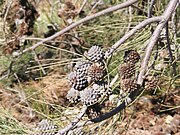
Allocasuarina torulosa, commonly known as forest oak, rose sheoak, river oak or Baker's oak, is a species of flowering plant in the family Casuarinaceae and is endemic to eastern Australia. It is a slender, usually dioecious tree that has drooping branchlets up to 140 mm (5.5 in) long, the leaves reduced to scales in whorls of four or five, and the fruiting cones 15–33 mm (0.59–1.30 in) long containing winged seeds 7–10 mm (0.28–0.39 in) long.

Allocasuarina distyla, commonly known as scrub she-oak, is a species of flowering plant in the family Casuarinaceae and is endemic to south-eastern New South Wales. It is a dioecious shrub that has branchlets up to 350 mm (14 in) long, the leaves reduced to scales in whorls of six to eight, the fruiting cones 13–35 mm (0.51–1.38 in) long containing winged seeds (samaras) 4.0–8.0 mm (0.16–0.31 in) long.

Casuarina glauca, commonly known as swamp she-oak, swamp buloke, swamp she-oak, marsh sheoak, grey she-oak, grey she-oak, native pine, or guman by the Gadigal people, is a species of flowering plant that is endemic to eastern Australia. It is a dioecious tree that often forms root suckers and has fissured and scaly bark, spreading or drooping branchlets, the leaves reduced to scales in whorls of 12 to 20, the fruit 9–18 mm (0.35–0.71 in) long containing winged seeds (samaras) 3.5–5.0 mm (0.14–0.20 in) long.

Allocasuarina verticillata, commonly known as drooping sheoak, is a species of flowering plant in the family Casuarinaceae and is endemic to south-eastern Australia. It is a small dioecious tree that has drooping branchlets up to 400 mm (16 in) long, the leaves reduced to scales in whorls of nine to thirteen, the mature fruiting cones 20–50 mm (0.79–1.97 in) long containing winged seeds 7–12 mm (0.28–0.47 in) long.

Allocasuarina littoralis, commonly known as black she-oak, is a species of flowering plant in the family Casuarinaceae and is endemic to eastern Australia. It is dioecious, or less commonly a monoecious tree or shrub, that has its leaves reduced to scales, usually in whorls of six to eight, the mature fruiting cones 10–30 mm (0.39–1.18 in) long containing winged seeds (samaras) 4.0–10 mm (0.16–0.39 in) long.
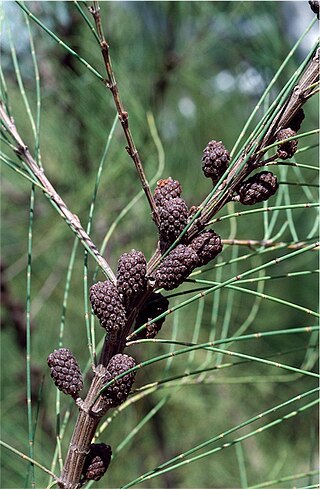
Allocasuarina portuensis, commonly known as Nielsen Park she-oak, is a species of flowering plant in the family Casuarinaceae and is endemic to a restricted part of the Sydney region in eastern New South Wales. It is a slender, dioecious shrub with branchlets up to 270 mm (11 in) long, the leaves reduced to scales in whorls of seven or eight, the fruiting cones 12–15 mm (0.47–0.59 in) long containing winged seeds 4–5 mm (0.16–0.20 in) long.
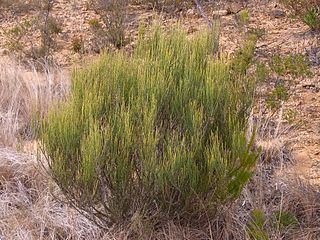
Allocasuarina nana, commonly known as dwarf she-oak or as stunted sheoak, is a species of flowering plant in the family Casuarinaceae and is endemic to south-eastern continental Australia. It is a low, spreading dioecious, rarely monoecious shrub that has branchlets up to 80 mm (3.1 in) long, the leaves reduced to scales in whorls of four to six, the fruiting cones 14–24 mm (0.55–0.94 in) long containing winged seeds 4–6 mm (0.16–0.24 in) long.

Allocasuarina inophloia, commonly known as stringybark she-oak, is a species of flowering plant in the family Casuarinaceae and is endemic to eastern Australia. It is a small dioecious tree that has finely fibrous, ribbony bark, its leaves reduced to scales in whorls of seven to nine, the mature fruiting cones 10–20 mm (0.39–0.79 in) long containing winged seeds (samaras) 5–6 mm (0.20–0.24 in) long.
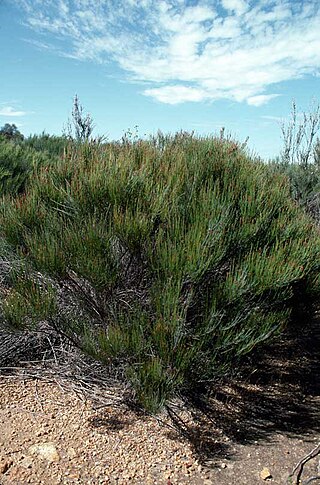
Allocasuarina campestris is a species of flowering plant in the family Casuarinaceae and is endemic to the south-west of Western Australia. It is a dense, monoecious or dioecious shrub that has more or less erect branchlets, the leaves reduced to scales in whorls of seven to nine, the mature fruiting cones 19–42 mm (0.75–1.65 in) long containing winged seeds (samaras) 4.7–10 mm (0.19–0.39 in) long.

Allocasuarina paludosa, commonly known as swamp she-oak or scrub sheoak, is a species of flowering plant in the family Casuarinaceae and is endemic to south-eastern continental Australia. It is a monoecious or dioecious shrub that has branchlets up to 200 mm (7.9 in) long, the leaves reduced to scales in whorls of six to eight, the fruiting cones 10–18 mm (0.39–0.71 in) long containing winged seeds 3.5–5.0 mm (0.14–0.20 in) long.

Allocasuarina paradoxa is a species of flowering plant in the family Casuarinaceae and is endemic to Victoria. It is a dioecious or monoecious shrub that has branchlets up to 150 mm (5.9 in) long, the leaves reduced to scales in whorls of seven to eleven, the fruiting cones 13–25 mm (0.51–0.98 in) long containing winged seeds 4–8 mm (0.16–0.31 in) long.

Allocasuarina dielsiana, commonly known as northern sheoak, is a species of flowering plant in the family Casuarinaceae and is endemic to the south-west of Western Australia. It is a dioecious tree that has more or less erect branchlets, the leaves reduced to scales in whorls of six to eight, and the mature fruiting cones 14–30 mm (0.55–1.18 in) long containing winged seeds (samaras) 8–10 mm (0.31–0.39 in) long.
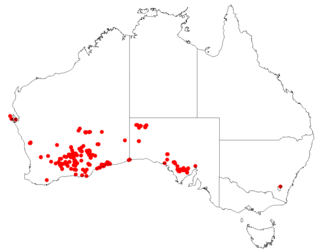
Allocasuarina helmsii is a species of flowering plant in the family Casuarinaceae and is endemic to the south-western Australia. It is a dioecious shrub that erect branchlets, the leaves reduced to scales in whorls of five or six, and mature fruiting cones 15–33 mm (0.59–1.30 in) long containing winged seeds (samaras) 4–5 mm (0.16–0.20 in) long.

Allocasuarina pinaster, commonly known as compass bush, is a species of flowering plant in the family Casuarinaceae and is endemic to the south-west of Western Australia. It is a prickly, dioecious shrub resembling a pine tree and that has its leaves reduced to scales in whorls of four, the mature fruiting cones 14–25 mm (0.55–0.98 in) long, containing winged seeds 10–11 mm (0.39–0.43 in) long.

Allocasuarina scleroclada is a species of flowering plant in the family Casuarinaceae and is endemic to areas along the south coast of Western Australia. It is a straggly, dioecious shrub that has branchlets up to 230 mm (9.1 in) long, the leaves reduced to scales in whorls of ten or eleven, the mature fruiting cones 18–25 mm (0.71–0.98 in) long containing winged seeds 5–8 mm (0.20–0.31 in) long.
Allocasuarina tessellata is a species of flowering plant in the family Casuarinaceae and is endemic to the south-west of Western Australia. It is a dioecious shrub or tree that has more or less erect branchlets, the leaves reduced to scales in whorls of eight or nine, the mature fruiting cones 26–55 mm (1.0–2.2 in) long containing winged seeds 5.0–7.5 mm (0.20–0.30 in) long.

Allocasuarina thuyoides, commonly known as horned sheoak, is a species of flowering plant in the family Casuarinaceae and is endemic to the south-west of Western Australia. It is monoecious or dioecious shrub that has its leaves reduced to scales in whorls of five or six, the mature fruiting cones 8–20 mm (0.31–0.79 in) long containing winged seeds usually 5.0–6.0 mm (0.20–0.24 in) long.

Allocasuarina trichodon is a species of flowering plant in the family Casuarinaceae and is endemic to areas along the south coast of Western Australia. It is a dioecious, rarely a monoecious shrub that has branchlets up to 300 mm (12 in) long, the leaves reduced to scales in whorls of eight to ten, and the fruiting cones 15–50 mm (0.59–1.97 in) long containing winged seeds 8–10 mm (0.31–0.39 in) long.

Allocasuarina muelleriana, commonly known as slaty sheoak, is a species of flowering plant in the family Casuarinaceae and is endemic to southern continental Australia. It is a dioecious, rarely a monoecious shrub that has branchlets up to 120 mm (4.7 in) long, the leaves reduced to scales in whorls of five to eight, the fruiting cones 14–30 mm (0.55–1.18 in) long containing winged seeds 6–9 mm (0.24–0.35 in) long.

Allocasuarina pusilla, commonly known as heath oak-bush or dwarf sheoak, is a species of flowering plant in the family Casuarinaceae and is endemic to south-eastern continental Australia. It is a spreading, dioecious shrub with branchlets up to 120 mm (4.7 in) long, the leaves reduced to scales in whorls of five to seven, the fruiting cones 10–15 mm (0.39–0.59 in) long containing winged seeds about 5 mm (0.20 in) long.



